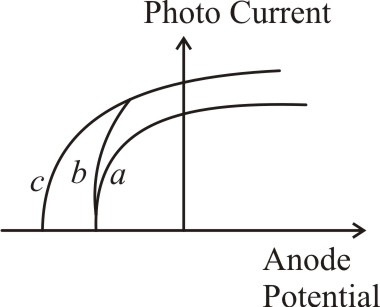A source \(S_1\) is producing, \(10^{15}\) photons per sec of wavelength \(5000~\mathring{A}.\) Another source \(S_2\) is producing \(1.02\times 10^{15}\) photons per second of wavelength \(5100~\mathring{A}.\) Then the ratio of the power of \(S_2\) to the power of \(S_1\) is equal to:
1.
\(1.00\)
2.
\(1.02\)
3.
\(1.04\)
4.
\(0.98\)

To unlock all the explanations of 14 chapters you need to be enrolled in MasterClass Course.

To unlock all the explanations of 14 chapters you need to be enrolled in MasterClass Course.
The potential difference that must be applied to stop the fastest photoelectrons emitted by a nickel surface, having work function 5.01 eV, when ultraviolet light of 200 nm falls on it, must be
1. 2.4 V
2. -1.2 V
3. -2.4 V
4. 1.2 V

To unlock all the explanations of 14 chapters you need to be enrolled in MasterClass Course.

To unlock all the explanations of 14 chapters you need to be enrolled in MasterClass Course.
2. 3 X 1016
3. 9 x 1015
4. 3 X 1019

To unlock all the explanations of 14 chapters you need to be enrolled in MasterClass Course.

To unlock all the explanations of 14 chapters you need to be enrolled in MasterClass Course.

2. Curves a and b represent incident radiations of the same frequency but of different intensities
3. Curves b and c represent incident radiations of different frequencies and different intensities
4. Curves b and c represent incident radiations of same frequency having the same intensity

To unlock all the explanations of 14 chapters you need to be enrolled in MasterClass Course.

To unlock all the explanations of 14 chapters you need to be enrolled in MasterClass Course.
2. threshold frequency (0)
3. intensity of light
4. frequency of light ()

To unlock all the explanations of 14 chapters you need to be enrolled in MasterClass Course.

To unlock all the explanations of 14 chapters you need to be enrolled in MasterClass Course.
1. ultraviolet region
2. visible region
3. infrared region
4. X-ray region

To unlock all the explanations of 14 chapters you need to be enrolled in MasterClass Course.

To unlock all the explanations of 14 chapters you need to be enrolled in MasterClass Course.
A particle of mass 1 mg has the same wavelength as an electron moving with a velocity of 3 x 106 ms-1. The velocity of the particle is :
(Mass of electron = 9.1 x 10-31 kg)
1.
2.
3.
4.

To unlock all the explanations of 14 chapters you need to be enrolled in MasterClass Course.

To unlock all the explanations of 14 chapters you need to be enrolled in MasterClass Course.
1. \(5\times 10^{15}\)
2. \(5\times 10^{16}\)
3. \(5\times 10^{17}\)
4. \(5\times 10^{14}\)

To unlock all the explanations of 14 chapters you need to be enrolled in MasterClass Course.

To unlock all the explanations of 14 chapters you need to be enrolled in MasterClass Course.
When photons of energy \(h\nu\) fall on an aluminium plate (of work function \(E_0\)), photoelectrons of maximum kinetic energy \(K\) are ejected.
If the frequency of the radiation is doubled, the maximum kinetic energy of the ejected photoelectrons will be:
1. \(K+ E_0\)
2. \(2K\)
3. \(K\)
4. \(K + h\nu\)

To unlock all the explanations of 14 chapters you need to be enrolled in MasterClass Course.

To unlock all the explanations of 14 chapters you need to be enrolled in MasterClass Course.
The momentum of a photon of energy 1 MeV in kg m/s, will be :
1.
2.
3.
4.

To unlock all the explanations of 14 chapters you need to be enrolled in MasterClass Course.

To unlock all the explanations of 14 chapters you need to be enrolled in MasterClass Course.






